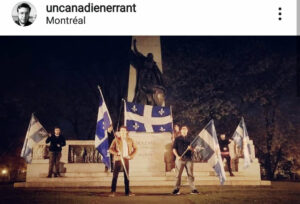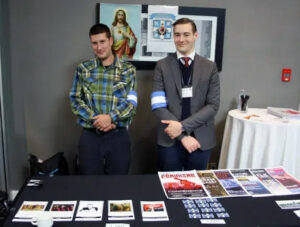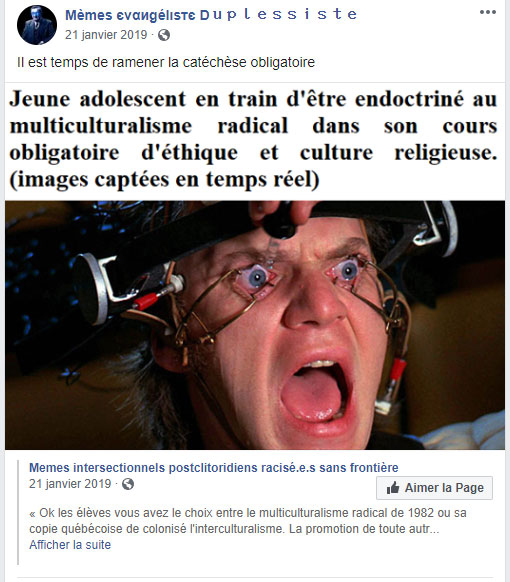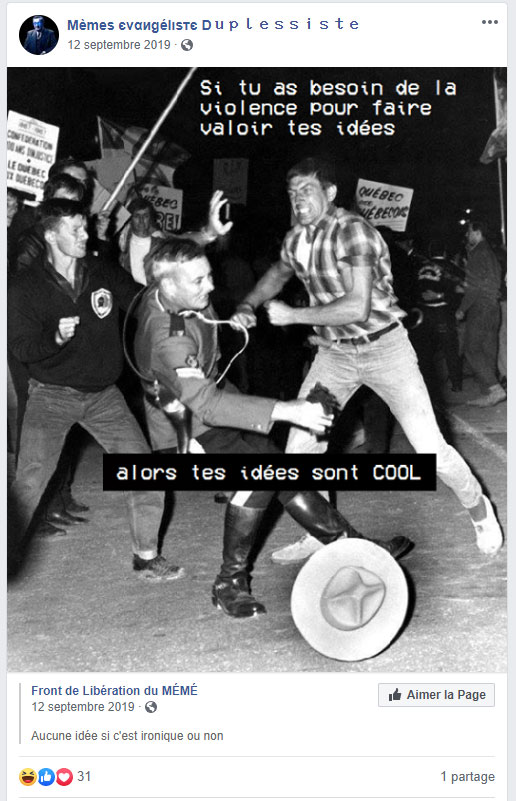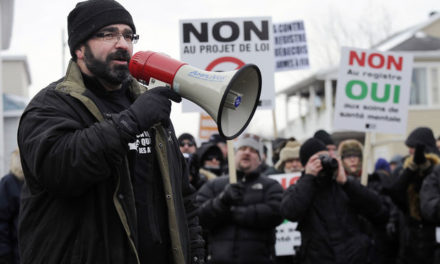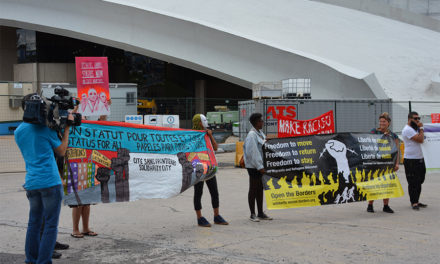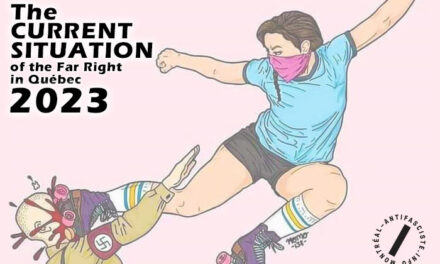In April 2020, at the peak of the COVID-19 pandemic, stickers started appearing in downtown Montreal neighbourhoods signed Frontcf.ca. The stickers alternately showed the Carillon-Sacré-Coeur (an obsolete flag harkening back to the halcyon days of the Catholic Church’s stranglehold on the Quebec state) or an archival illustration of Jacques-Cartier raising a cross in 1534, and were linked to the internet site of the so-called “Front canadien-français,” a previously unknown organization. A brief overview of this groupuscule appears on its website, along with a series of retrofuturist/fashwave illustrations and a handful of photos of anonymous “actions,” all of which also appear on various relatedTwitter, Instagram, and Facebook pages.
While checking out these young throwbacks, we were tempted to simply mock their retrograde programme torn straight out of the Grande Noirceur. However, what the handful of young militants who make up the FCF were foolish enough to reveal on social media allowed us to make a direct link between this little band of backwards zoomers and some more deeply rooted sections of the Quebec far right, specifically the Catholic traditionalist nationalists who have been quietly forging a path for a few decades now.
– >>> Who are the militants of the Front canadien-français (go directly to the photo gallery)
Here’s a portrait of a group of misfits in their twenties and the fascist old guard in whose footsteps they hope to someday follow.
(6,000 words; a twenty-minute read)
///
In spring 2020, at the peak of the COVID-19 pandemic, we took note of a number of things that had occurred over the previous months that suggested a new network coming together in Montreal: the appearance in 2019 of a plethora of almost identical reactionary meme web pages propagating fundamentalist, hyperconservative, racist, and transphobic Catholicism;[i] the January 2020 publication of a “Manifeste contre le dogmatisme universitaire” [Manifesto against Academic Dogmatism], co-signed by sixty reactionary students; the appearance on Nomos.tv (YouTube channel of the ultranationalist Horizon Québec Actuel) of a Catholic militant who was circulating a stupefying “Lettre ouverte aux évêques de l’Église catholique au Canada français” [Open Letter to the Bishops of the Catholic Church in French Canada]; the increasingly frequent appearance of the Carillon-Sacré-Coeur flag,[ii] for example, at protests (Vague bleue on May 4, 2019 and the mass climate march on September 27, 2019) and on stickers in different locations around the city; and finally, the online appearance of the FrontCF.ca website, promoted with new stickers on Montreal’s streets, with content that was tied to at least one of the meme pages mentioned above.

One of the many FCF stickers seen around Montreal in the spring of 2020. It sports the Carillon-Sacré-Coeur.
Then there was a series of actions presented on the Twitter, Instagram, and Facebook accounts of the new groupuscule, actions that encompassed the usual range of activities of social movements (both left and right). The youth who make up the Front canadien-français seem to model their activism on organizations like Action Française (royalist and Catholic, France) and Atalante in Quebec, in particular. A few weeks ago, they used social media to webcast one of their stickering actions, before gathering at various historic monuments waving flags and even cleaning the monuments to show their love for the glorious past. Obviously, these actions are intended to draw attention to their project and eventually recruit new members (confirmed by the “Rejoins nos rangs!” [Join our ranks!] signoff at the end of their texts).
So far, the FCF stickers have appeared in Montreal and some spots on the North and South Shores. They didn’t officially claim their first action as theirs, but it was publicized on members’ Instagram accounts and the Facebook page of the Mouvement des Jeunes Souverainistes;[iii] it was a gathering at the Dollard des Ormeaux monument in Parc La Fontaine, in Montreal, on May 18, 2020, to celebrate the Journée nationale des Patriotes, previously known as Fête de Dollard.
Thereafter, the FCF militants published photos of a homage to Lionel Groulx, held on May 23 at the tomb of the notoriously antisemitic cleric, in Vaudreuil. The commemoration of the death of Lionel Groulx was presided over by Alexandre Cormier-Denis (we’ll get back to him in a bit) of Horizon Québec Actuel, who broadcast a recording of the event on the YouTube channel Nomos.tv. A number of FCF members, including Jason McNicoll Leblanc and Jean-Philippe Desjardins Warren, acknowledged their presence on their respective Instagram accounts.We also recognize two other members who were not masked at the event, Vincent Benatar and Alexis Larose. Benatar read a letter from Father Daniel Couture, in which the eminent member of the Society of Saint Pius X (SSPX; more on that organization below) expressed his regret at being unable to attend the commemoration.
In the following weeks, footage was posted of FCF members cleaning two statues in Montreal: those of Camille Laurin (the father of Bill 101) and Archbishop Ignace Bourget, exhibiting tremendous “courage” tearing down a Black Lives Matter banner along the way.
We presume that the FCF militants will soon be training in Thai kick-boxing and handing out Paris Pâté sandwiches to affirm their kinship with Atalante!
One thing we know for sure, the background presence of organizations like the SSPX and Horizon Québec Actuel makes it safe to assume that the FCF has ties to a far-right tendency that has deep roots going back a long way in Quebec.
Who (or What) Do the Militants in the Front canadien-français Want to be the Youth League Of?
The historian Roger Griffin defines fascism as a “revolutionary form of palingenetic ultranationalism.”[iv] The infrequently used term palingenesis derives from Greek and means rebirth or regeneration, i.e., a return of “that which already was and no longer is.” In the context of an ultranationalist programme, it refers to the eventual rebirth of the idealized nation (considered the most important interest), the“revolutionary” qualifier implying an eventual recourse to insurrectional means (or at least the threat thereof) to achieve this rebirth.
The sanitized boneheads of Atalante, for example, describe themselves as “revolutionary nationalists”—we have already documented this tendency and its line of descent in some detail— and Atalante fits the above definition to a T, as do some other marginal and more or less organized groupuscules and individuals (in the National Socialist Black Metal [NSBM] and alt-right scenes, for example).
There is, however, another far-right current in Quebec that has been active for much longer, and that we’ve rarely discussed, the principal groups within which describe themselves explicitly as “counter-revolutionary.”
While these groups often have a spiritual emphasis, there is much about them that suits Griffin’s definition of fascism. To varying degrees, they all view the French Canadian nation as suicidally decadent and ravaged by the loss of its (imaginary) traditional culture, changing gender norms, and secularization. Additionally, they all view the Roman Catholic Church as similarly beset by decline —contaminated by left-wing ideas and a pathetic desire to “fit in” to the modern world, exemplified for many of them by the suppression and marginalization of the Latin “Tridentine” Mass— and in need of a restoration. Finally, they consider various right-wing dictatorships like Franco’s Spain (1939–1977) or Salazar’s Portugal (1933–1974) as positive reference points within their tradition. Closer to home, the government of Maurice Duplessis (1936–1939, 1944–1959) —which viciously suppressed strikes, outlawed communist meetings (the padlock law), jailed religious minorities, and rigged elections— is considered a model.
Internationally, this current took form after the Vatican II reforms in the 1960s; they are fond of bemoaning the fact that before then their opinions were the “mainstream” of Catholicism. What ensued was years of debate within the Church, as well as splits, as certain Catholics either left or were excommunicated, leading to the odd situation of some of the most hard-core Catholics being kicked out of the official Roman Catholic Church for being too attached to their vision of traditional Catholicism.
The prime example of this for many years was the Society of Saint Pius X, founded by Mgr. Marcel Lefebvre in Switzerland as a haven for Catholics who refused to give up the Latin Mass and all that it symbolized. After years of conflict with the Vatican, Lefebvre and other leading SSPX members were excommunicated in 1988[v].
It is important to understand that this is not just a religious dispute. For members of the SSPX, the Vatican’s opening to modern realities was seen as proof of an evil worldwide conspiracy that had somehow allowed the “smoke of Satan” to enter the Church. Who was behind this conspiracy? Depending on who one asked, it was the Freemasons, the Communists, the Illuminati, or the Jews. But frequently, drawing on long historical traditions of right-wing scapegoating and polemicizing within the Church, theories were elaborated showing how all these forces had worked together for centuries to destroy the Church and bring about a godless one-world government (the Protestant Reformation, the French Revolution, the rise of human rights and democracy, changes in gender roles, and reforms to the Church all being aspects of this plot). As such, the SSPX (like other Catholic traditionalists) frequently overlapped with various far-right political currents; Lefebvre made no secret of his support for Jean-Marie Le Pen’s Front national, the Franco dictatorship in Spain, Salazar in Portugal, Jorge Videla in Argentina (1976–1983),and Augusto Pinochet in Chile (1973–1990). In 1989, it was revealed that for some sixteen years members of the SSPX and the Ordre des chevaliers de Notre-Dame had been harbouring Paul Touvier, indicted for his central role in the deportation of the Jews of Lyons to German death camps—Touvier, aged seventy-four, was finally arrested at the Lefebvrist St. Francis Priory in Nice[vi].
In Quebec, the alienation of certain right-wing Catholics following Vatican II was exacerbated by changes that had taken place during the so-called Quiet Revolution. The result, at first, was a tiny and fragmented landscape, the main focuses of serious activity being support for the Latin Mass and resistance to the Parent Commission’s (1961–1964) plans to secularize the Quebec school system. In time, opposition to abortion would also become a focus. All the while, there was a cross-pollination between this scene and other far-right traditions, conspiracy theories being an important part of the shared framework. Various members of the Latin Mass community were: active in Adrien Arcand’s openly Nazi Parti de l’Unité Nationale du Canada; served as officials with the Regroupement Scolaire Confessionel (which controlled the most important Montreal school board for much of the 1980s and 1990s), which was repeatedly revealed to be connected with racist, anti-abortion, and even openly fascist organizations; were part of the Ralliement Provincial des Parents de Québec, which ended up serving as a base for the Centre d’information nationale Robert Rumilly, founded in 1990.

Jean-Claude Dupuis, former key militant in the Cercle Jeune Nation, now closely associated with the SSPX and the Mouvement Tradition Québec.
From 1993 to 1995, the Lefebvrists maintained a study group at Université Laval in Ste-Foy, which at the time was a favourite recruiting ground for Catholic traditionalists. The Cercle d’études des jeunes catholiques traditionalistes (CEJCT) organized lectures by far-right speakers from Canada, the United States, and Europe, including several leading members of Le Pen’s Front national, as well as by local luminaries like Jean-Claude Dupuis and Louis-Michel Guilbault (see below). These speaking tours were often orchestrated in concert with the CINRR and RPPQ, and also with another organization, perhaps the most important far-right group in Quebec at the time, the Cercle Jeune Nation (CJN).
The CJN was founded in 1986 but was most active in the 1990s. Modeled on LePen’s Front national, the CJN was meant to be a big tent within which different far-right currents could co-exist and put forth shared positions. Founded in part by veterans of Quebec’s tiny fascist and Nazi traditions, for many members the hope was to elaborate a credible right-wing critique of the Quiet Revolution and to contest supposed left-wing hegemony within the nationalist movement. The CJN worked with numerous racist and far-right organizations. Its journal, the Cahiers de Jeune Nation, published articles by Dimitri Kitsikis, professor of history at University of Ottawa, as well as by François-Albert Angers, the patriarch of Québécois nationalism. There were also contributions from overseas, including from Michael Walker and Thomas Molnar, European adherents of the Groupement de recherche et d’études pour la civilisation européenne (GRECE; the fascist spawning grounds of the European New Right) and Gunter Deckert, the future president of the German crypto-Nazi Nationaldemokratische Partei Deutschlands.
The CJN’s diverse composition ended up being too ambitious; it folded in 1994 following a split between those who felt some of the religious positions being put forth were hurting its credibility and others who considered this bashfulness to be hypocritical. While most members of the CJN were not Lefebvrists, the editor of Cahiers de Jeune Nation, Jean-Claude Dupuis, was a member of the SSPX, and the Cercle repeatedly worked with Lefebvrists, as well as with other far-right Catholics, for instance, those in the CINRR.
In many ways, the CJN’s base of support paralleled that of the current Fédération des québécois de souche. The main difference being that the CJN successfully and openly reached out to certain right-wing elements within the nationalist milieu and occupied pride of place on the far-right stage during its time. As for the FQS, thanks in part to its open and well-documented neo-Nazi origins, it exists at greater distance from the “legitimate” right wing, while sharing the far-right stage with a greater number of actors, not only other fascists (Atalante, etc.) but a currently deflated national-populist movement as well.
It is striking to what extent the constellation of political forces outlined above remains in place today.The co-founders of the Cercle Jeune Nation, Roch Tousignant and François Dumas, for example, are now connected to the Fédération des québécois de souche (FQS), while another pillar of that organization, Jean-Claude Dupuis, remains closely tied to the SSPX, working as a history teacher at its École Sainte-Famille in Lévis.
What we see is a coherent political milieu that has managed to reproduce itself, successfully maintaining continuity, despite occupying distinct structures and in a changed political environment, drawing in some new members in the process, while also retaining others from decades ago.
Today, the Lefebvrist current in Quebec is principally represented by the Cercle Tardivel, the Mouvement Tradition Québec, and the Éditions de la Vérité, all under the tutelage of trusted SSPX militants. The three entities are registered with the Quebec Business Registry under the names of Kenny Piché, Étienne Dumas, and Julien Chapdelaine[vii]. Piché and Dumas have already been dealt with by the antiracist blogger Xavier Camus (see, here and here). Chapdelaine, for his part, seems to be close to the FQS and served as the official agent for the neo-Nazi Sylvain Marcoux during the most recent provincial elections.
The young reactionaries in the Front canadien-français are, as such, the direct heirs of a specific retrograde, far-right, ultra-Catholic tradition that is steeped in nostalgia for a premodern Quebec. In spite of the counter-revolutionary label that they have adopted from the predecessors, these new recruits, in fact, have strongly fascistic proclivities, as can be seen in their public writings and on their social media pages (see below). They are ethnic nationalists (racists and adherents of the Great Replacement thesis), opponents of diversity and equality, and nauseatingly heteropatriarchal (anti-feminist, with an ideological and moral objection to abortion). They advocate a return to “traditional values”and what they characterize as the golden age of the French Canadian nation: a period marked by the Catholic Church’s stranglehold on society and political affairs (Ultramontanism), large families in which women were stripped of all power and had no control over their reproductive health, and an authoritarian, populist, and hyper-conservative government not troubled by democratic process or civil liberties, of which Maurice Duplessis remains the revered standard-bearer.
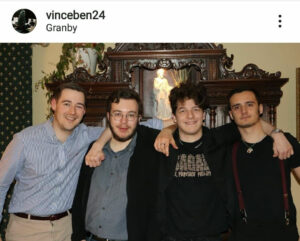
Étienne Dumas, of the Mouvement Tradition Québec, hanging out with Jason McNicoll Leblanc, Vincent Benatar, and Alexi Larose, of the Front canadien-français.
Links with the FQS and the Influence of Horizon Québec Actuel
A word in passing about the Fédération des Québécois de souche (FQS), in whose shadow the FCF seem to have developed. The FQS was founded in 2007 by neo-Nazis (including the repentant Maxime Fiset) and continues to exist today as a federation of various different far-right nationalist currents (some of which hold mutually incompatible positions), sort of like the Cercle Jeune Nation did in its day.
You will find flat-out neo-Nazis published in the pages of the FQS’s magazine, including Sylvain Marcoux and his perennial project the Rassemblement national canadien-français, the so-called “revolutionary” fascists of Atalante under the pseudonym Alexandre Peugeot (likely the alter ego of Antoine Mailhot-Bruneau, similar to the FQS’s composite pseudonymous author Rémi Tremblay), as well as others representing various tendencies. We particularly note the profound influence of the Lefebvrist current, in the form of the Mouvement Tradition Québec and related groups from the traditionalist circles described above.
We note that the FCF network includes a certain number of individuals who are connected to the FQS to some degree through its traditionalist and counter-revolutionary current, among them Étienne Dumas and Louis-Michel Guilbault (“Louis Roy,” on Facebook), a rabid traditionalist of long-standing[viii] who now specializes in the production of junk store merchandise, e.g., Carillon-Sacré-Cœur flags, plastic Maurice Duplessis busts (!), and other locally produced gewgaws, which he distributes through his business, Ludovidec (registered in the name of Louis-Rémi Guilbault at the Business Registry).
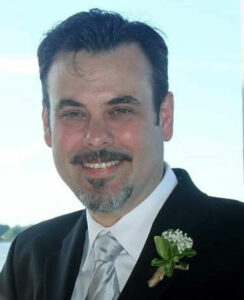
Louis-Michel Guilbaut’s Facebook profile photo. This ultranationalist militant of long-standing is a close sympathizer of the Fédération des québécois de souche, is behind the “Louis Roy” Facebook profile, and manages Ludovidec, an online store selling traditionalist gewgaws.
Besides their links to the Mouvement Tradition Québec and the SSPX, it is also clear that the Front canadien-français militants move in the orbit of Horizon Québec Actuel, the ultranationalist project coordinated by Alexandre Cormier-Denis and Philippe Plamondon.
Cormier-Denis is on the way to becoming a key figure on the Quebec far right. Via the YouTube channel Nomos.tv, this adept of Marine Le Pen and the Rassemblement national (formerly, the Front national) is a major ethnic nationalist, reactionary, and racist propagandist: in favor of an exclusive ethnic/identitarian nationalism, anti-immigrant (amplifying the Great Replacement thesis), Islamophobic, anti-progress, antifeminist, anti-choice, anti-diversity, etc. As well as his numerous videos on Nomos.tv, Cormier-Denis regularly collaborates with Vigile.Québec (a right-wing nationalist platform) and is sometimes asked to comment upon different issues, which serves to legitimize his toxic ideas which he never misses an opportunity to trumpet. Notably, in 2019, he was a guest on Télé-Québec’s Zone Franche to debate the question: “Are we welcoming too many immigrants to Quebec?” We leave his answer to your imagination. More recently he garnered attention during a QUB Radio interview, when the homophobic nature of his comments pushed the host to break off the interview (albeit after twenty minutes of rambling), causing his supporters to scream “censorship!” He and Plamondon host a variety of guests on Nomos.tv, including a recent clearly pre-prepared interview with Raphaël Lévesque, the leader of Atalante, which unfolded in the spirit of a profoundly harmonious complicity.
Even if they farcically object to accusations of racism, Cormier-Denis and his acolytes intervene regularly to deplore the “bastardization” of Western societies that results from“mass immigration,” a racist dog-whistle about as subtle as a neon lit marquee. Remember that in 2017, his election campaign under the banner of the Parti indépendantiste (considered a Front national satellite in Quebec and regularly decried over the years for its proximity to neo-Nazi militants) was marked by a mini-scandal over a grotesquely Islamophobic and xenophobic election poster (copied from the Front national).
(For more information, consult our page on Horizon Québec Actuel.)
Considering the obvious ideological proximity of Horizon Québec Actuel and the Front canadien-français, it’s not particularly shocking that the two projects should end up working together. On May 23, 2020, at the commemoration of the death of Lionel Groulx organized by the FCF in Vaudreuil, it was none other than Alexandre Cormier-Denis who served as the master of ceremonies. In the video of the commemoration published on Nomos.tv, Alexi Larose appears among the young militants of the FCF; it would seem that Larose lives at the same address as Philippe Plamondon… doubtless just a coincidence, of course.
Given all of these connections, it seems fair to ask if the FCF is anything more than the latest band of useful idiots being ideologically shaped in the shadows of the Fédération des Québécois de souche, the SSPX, the Mouvement Tradition Québec, and Horizon Québec Actuel.
An Odd “Open Letter to the Bishops”
In November 2019, on their respective websites, Campagne Québec-Vie (an anti-abortion group) and the SSPX published a “Lettre ouverte aux évêques de l’Église catholique au Canada français,” [Open Letter to the Bishops of the Catholic Church of French Canada] signed by one Julien Bertrand.[ix] We note a very strong similarity between a passage in this text and one in a different “open letter” published on the FCF website shortly thereafter. The language, vocabulary, and ideas are more or less identical in the two texts, and the sentence immediately below appears identically in both letters, which leads us to believe that both letters were written by the same author or authors:
« À l’image de notre saint patron Saint Jean le Baptiste, nous sommes la voix qui crie au milieu des ruines de béton et des nids de poule. Il est de notre devoir de hurler au nom de nos frères qui se suicident et de notre peuple qui se meurt. » [In the image of Saint John the Baptist, our patron saint, we are a voice crying out in a wasteland of cement and potholes. It is our responsibility to howl in the name of our brothers who are committing suicide and of our people which is dying.]
 On December 6, 2019, Julien Bertrand was invited to explain to the Nomos.tv audience what had led him to write his letter. That same day, Vincent Benatar, also a signatory, plugged his “good friend Julien”on the Mèmes evangeliste duplessiste Facebook page, then the following week, he was interviewed by E. Michael Jones, an American Catholic traditionalist infamous for his antisemitism, on the same subject.
On December 6, 2019, Julien Bertrand was invited to explain to the Nomos.tv audience what had led him to write his letter. That same day, Vincent Benatar, also a signatory, plugged his “good friend Julien”on the Mèmes evangeliste duplessiste Facebook page, then the following week, he was interviewed by E. Michael Jones, an American Catholic traditionalist infamous for his antisemitism, on the same subject.
Everything points to Julien Bertrand being another key member of the FCF.
The Young Anti-modernists… and Their Meme Game
One specific characteristic of this new generation of wannabe Ultramontanists is their affection for the distinctive lexicon of memes (in spite of the conspicuous aversion for “modernity”). A management student at UQAM, Vincent Benatar distinguishes himself by his prolific publications on the Facebook page he administers, Mèmes evangeliste duplessiste (sic).

As is the case with the FCF’s contributions, the “Lettre aux évêques catholiques” which he co-signed, and the text he published on Vigile.quebec about the Great Replacement,[x] a look at the content of this Facebook page reveals the profoundly reactionary and racist nature of the political programme advanced by Benatar and his coterie, which corresponds entirely to that of the traditionalist Catholic current discussed above.


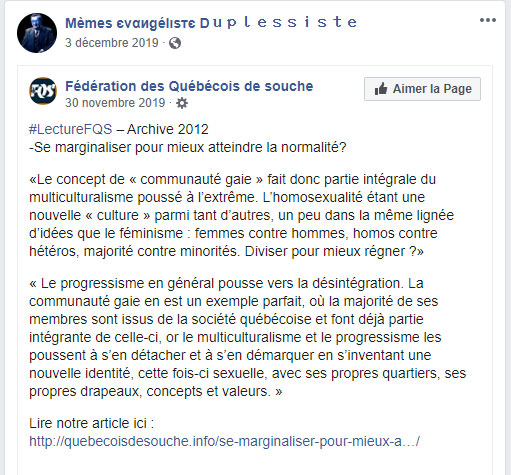
Browsing through older posts clarifies Benatar’s evolution. He was a big supporter of Bill 21on the “laicity of the state,” until he realized that the principles behind secularism directly contradict Ultramontanist values, his all-embracing ideological framework. Benatar’s misogynist and racist commentaries, memes, and columns are simply too numerous to list, but here are some examples:
Below are the names of various other websites of a similar quality that we suspect are either in the FCF’s orbit or else connected to the social network it evolved out of (don’t hesitate to get in touch with us if you have information about these websites and their administrators):
- Mèmes єναиgélιѕтє Duplessiste
- Mesmes tradis sans retenue 𝖉𝖚 𝖇𝖆𝖗𝖔𝖓 𝖉𝖊 𝕷𝖔𝖓𝖌𝖚𝖊𝖚𝖎𝖑
- Memes nationalistes pour zoomers Québécois
- Mèmes clérico-nationalistes du Canada français
- Memes merveilleux à la mémoire de Montcalm
- Un mémé couleur de Radio-Cadenas
- Memes Groulxiens d’instruction publique
- Memes nationalistes québécois
Another thing that is revealed by Benatar’s meme pages as well as his personal website, is the nature of the online network around this project. Benatar’s friends list includes a dozen Atalante militants and sympathizers (including Raphaël Lévesque and his wife Danielle Doukas, Benjamin Bastien, Antoine and Étienne Mailhot-Bruneau, Yannick Vézina, Renaud Lafontaine, and Quentin “Jean Brunaldo” Pallavicini), as well as a number of people connected to the Fédération des québécois de souche (among them, “Rémi Tremblay,” Louis-Michel Guilbault/Louis Roy, and Patrick Savoie), Étienne Dumas of the Mouvement Tradition Québec, Guillaume Beauchamp of the duo of idiots known as DMS, alt-right Nazi wannabe Jean-Philippe Robert (JP Bobby), Charlottesville veteran Vincent Bélanger Mercure (who is also “Super Fan” on Mèmes evangeliste duplessiste), anti-Muslim propagandist Daniel Laprès, the tres amigos known as the Exilés (Félix Brassard, Michael Lauzon, and Samuel Vanasse), the anti-Semite Georges Tremblay, the neo-Nazi Sylvain Marcoux, Philippe Plamondon of HQA, etc… rubbing shoulders with NSBM pagan Tom Samson (not very Christian, that) and PQ leadership candidate Frédéric Bastien!
Who Are the Front canadien-français Activists?
| Vincent Benatar Instagram @vinceben24 https://www.facebook.com/vincent.benatar.90 https://twitter.com/benatarvince  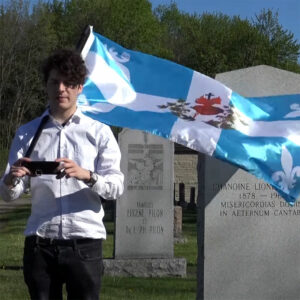 Benatar has been on our radar for a few months. He signed the “Manifeste contre le dogmatisme universitaire” [Manifesto against Academic Dogmatism] as a management student at ESG-UQAM. He is a practicing traditionalist who studied at Collège Bourget, a Catholic private school. He seems to have become close to Atalante in recent years (he is friends with a number of key Atalante members and interacts with them regularly). He administers at least one page of far-right memes, “Mèmes evangeliste duplessiste”, and signed an extremist-oriented article titled “Après le Grand Remplacement. Que faire lorsque nous serons minoritaires?,” [After the Great Replacement. What Will We Do When We’re a Minority?], published on the Vigile.quebec website and reposted by Horizon Québec Actuel and the Fédération des Québécois de souche. Benatar has been on our radar for a few months. He signed the “Manifeste contre le dogmatisme universitaire” [Manifesto against Academic Dogmatism] as a management student at ESG-UQAM. He is a practicing traditionalist who studied at Collège Bourget, a Catholic private school. He seems to have become close to Atalante in recent years (he is friends with a number of key Atalante members and interacts with them regularly). He administers at least one page of far-right memes, “Mèmes evangeliste duplessiste”, and signed an extremist-oriented article titled “Après le Grand Remplacement. Que faire lorsque nous serons minoritaires?,” [After the Great Replacement. What Will We Do When We’re a Minority?], published on the Vigile.quebec website and reposted by Horizon Québec Actuel and the Fédération des Québécois de souche. |
| Jason Mc Nicoll Leblanc Instagram @uncanadienerrant https://www.facebook.com/jason.leblanc2799   Student at or graduate of Cégep Édouard-Montpetit, this former Fraternity of Saint Peter sympathizer seems to have joined the Society of Saint Pius X. He also seems to be a key FCF member and is very active on social media—he manages the Instagram and Facebook @penséelaurentienne accounts and the Instagram @carillonsacrécoeur account, and likely also the FCF’s Instagram, Twitter, and Facebook accounts. It is thanks to his indiscretion that we were able to uncover the identities of the members of the group; he shared a photo on his Instagram account of a public FCF action in which all of the members were identified. The photo has since been deleted, but unfortunately for him, we already had it. Student at or graduate of Cégep Édouard-Montpetit, this former Fraternity of Saint Peter sympathizer seems to have joined the Society of Saint Pius X. He also seems to be a key FCF member and is very active on social media—he manages the Instagram and Facebook @penséelaurentienne accounts and the Instagram @carillonsacrécoeur account, and likely also the FCF’s Instagram, Twitter, and Facebook accounts. It is thanks to his indiscretion that we were able to uncover the identities of the members of the group; he shared a photo on his Instagram account of a public FCF action in which all of the members were identified. The photo has since been deleted, but unfortunately for him, we already had it. |
| Alexi Larose Instagram @Alexeain https://www.facebook.com/alexi.larose https://ca.linkedin.com/in/alexi-larose-6b3a15147   A friend of Vincent Benatar, he has participated in every FCF action. His Instagram account and his stubborn insistence on heavily stickering outside his home tells us that he lives on thePlateau Mont-Royal. . .at the same address as Philippe Plamondon, the vice-president of Horizon Québec Actuel. Out of Christian charity, we won’t publish his address here. A friend of Vincent Benatar, he has participated in every FCF action. His Instagram account and his stubborn insistence on heavily stickering outside his home tells us that he lives on thePlateau Mont-Royal. . .at the same address as Philippe Plamondon, the vice-president of Horizon Québec Actuel. Out of Christian charity, we won’t publish his address here. |
| Jean-Philippe Desjardins-Warren Instagram @harfanglaurentien https://www.facebook.com/jeanphilip.warren 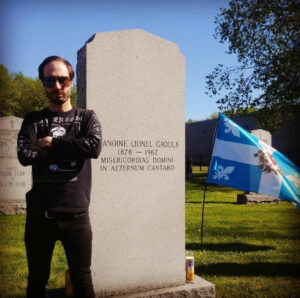  A Longueuil resident and a history student at UQAM, this good friend of Jason McNicoll Leblanc is hardly a stranger to us. He spent some time in the punk scene, eventually gravitating to the Montreal underground milieu, while a student at Cégep du Vieux-Montréal. He then moved on to the Quebec black metal scene, where he developed some unsavoury relationships. . .Earlier this year, he signed the aforementioned “Manifeste contre le dogmatisme universitaire,” going on to participate in FCF actions. He is also involved in the youth council of the Société Saint-Jean-Baptiste. A Longueuil resident and a history student at UQAM, this good friend of Jason McNicoll Leblanc is hardly a stranger to us. He spent some time in the punk scene, eventually gravitating to the Montreal underground milieu, while a student at Cégep du Vieux-Montréal. He then moved on to the Quebec black metal scene, where he developed some unsavoury relationships. . .Earlier this year, he signed the aforementioned “Manifeste contre le dogmatisme universitaire,” going on to participate in FCF actions. He is also involved in the youth council of the Société Saint-Jean-Baptiste. |
| Suleyman Ennakhili Instagram @suleyman.ennakhili https://www.facebook.com/suleyman.ennakhili  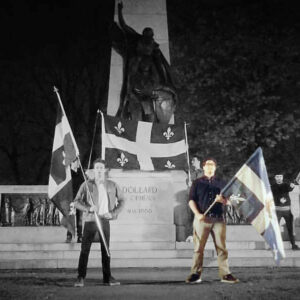 Besides participating in FCF actions, we’ve seen him sporting the Carillon-Sacré Coeur on two occasions: at the Islamophobic Vague bleue demonstration in Montreal on May 4, 2019 (ironically, standing behind the national-populists’ pro-secularism banner) and at the mass climate march on September 27, 2019. Originally from Pointe-Calumet, he may well be behind the appearance of FCF stickers at Saint-Joseph-du-Lac. Besides participating in FCF actions, we’ve seen him sporting the Carillon-Sacré Coeur on two occasions: at the Islamophobic Vague bleue demonstration in Montreal on May 4, 2019 (ironically, standing behind the national-populists’ pro-secularism banner) and at the mass climate march on September 27, 2019. Originally from Pointe-Calumet, he may well be behind the appearance of FCF stickers at Saint-Joseph-du-Lac. |
| Francois Gervais https://www.facebook.com/profile.php?id=100011065410118   A friend of Suleyman Ennakhili, he was with him and also sporting the Carillon-Sacré Coeur at the mass climate march on September 27, 2019. He was also a signatory of the “Manifeste contre le dogmatisme universitaire,” as a student of the history of civilization at Cégep Lionel-Groulx. He is likely responsible for the stickers that have appeared in Vieux Sainte-Thérèse. A friend of Suleyman Ennakhili, he was with him and also sporting the Carillon-Sacré Coeur at the mass climate march on September 27, 2019. He was also a signatory of the “Manifeste contre le dogmatisme universitaire,” as a student of the history of civilization at Cégep Lionel-Groulx. He is likely responsible for the stickers that have appeared in Vieux Sainte-Thérèse. |
| Julien Bertrand https://www.facebook.com/julien.bertrand1534   Julien Bertrand was the lead signatory and main promoter of the “Lettre ouverte aux évêques catholiques au Canada français,” certain passages of which are identical to passages in another open letter published on the Front canadien-français website. As a bonus, below is a commentary from Julien Bertrand that is in no way racist and reflects a deep understanding of Christ’s message of universal love. Julien Bertrand was the lead signatory and main promoter of the “Lettre ouverte aux évêques catholiques au Canada français,” certain passages of which are identical to passages in another open letter published on the Front canadien-français website. As a bonus, below is a commentary from Julien Bertrand that is in no way racist and reflects a deep understanding of Christ’s message of universal love. |
New day, but same old shit. . .
In and of itself, the Front canadien français has not done much—some stickers, a few online texts, a couple of tiny public outings. But the group provides a useful window into a number of fascist and fascist-adjacent networks that have remained active in Quebec for generations now. We do not use the term “fascist” loosely; even if these currents often define themselves as “counter-revolutionary,” and we are sympathetic to the view that fascism is a revolutionary current, it is important to not apply this criterion mechanistically: when members of the FCF and their friends claim to be counter-revolutionary they are referring to the French Revolution, or maybe the Quiet Revolution, but their vision definitely entails completely overturning the current system to impose their dystopian beliefs.
Unlike the boomer clowns from La Meute, Storm Alliance, and the other national-populist outfits, the activists in these networks are not generally fond of publicity. The established fascist networks in Quebec are not hoping to win the next election or change government policy over the next six months—they understand their struggle in a more protracted sense, and consistently set their sights on the more modest objective of building small but durable bases of support and encouraging supportive cultural and intellectual developments. As such, they constitute a subculture that has managed to sustain and reproduce itself from one generation to the next. This is a version of the metapolitical strategy elaborated by the European far right following the defeats of the 1960s. Whereas May 68 and Algerian independence provoked this defensive strategy in France, in Quebec it was the Quiet Revolution that did so.
As to the odd religious proclivities of many Quebec fascists and their hangers-on: we do not care if people prefer that Church services be held in French or Latin (or any other language). We do, however, recognize that for these far rightists, religion is an important symbolic terrain on which to quickly stake out, as if in shorthand, opposition to a wide range of features of contemporary life—anything that clashes with their imagined French Canadian past that never really existed, in which everyone was white, Catholic, heterosexual, and aspired to have thirty children—and to also symbolically align themselves with a long (if generally marginal) tradition of political activism that goes all the way back to the (fanatically pro-federalist!) Nazi AdrienArcand.
Every nation has its culture and its history, always full of contradictions and countercurrents but always also with an “official” version that reactionaries mistake for the whole truth. In Quebec, the obvious religious reference point in Catholicism, and so our young fascist wannabes simply select the flavour of Catholicism that best aligns with their political views—and, predictably, they select the one that is so far to the right that it actually found itself temporarily outside of the Church.
It is difficult to say whether or not the FCF will last more than a few months; however, those who established it are likely to remain active within this broader far-right tradition. We will be watching.
[i] According to Wikipedia, Internet memes are “image macrospaired with a concept or catchphrase” and is “spread via the Internet, often through social media platforms.”
https://en.wikipedia.org/wiki/Internet_meme
[ii] The Carillon-Sacré-Coeur, particularly beloved by reactionary nationalists in Quebec, is a version of the “official” flag of French Canada that was favoured by some Catholic nationalists from 1903 to 1935. In 1926, It was adopted as the official flag of the Société Saint-Jean-Baptiste. Besides commemorating the French victory at the Battle of Fort Carillon, the inclusion of the Sacré-Cœur symbolizes the Catholic Church’s influence on and domination of the nation, in short, the Ultramontanist principle aspired to by this ultra-Catholic tradition. Description : « Sur fond d’azur se détache une croix blanche, portant au centre l’emblème du Sacré-Cœur rayonnant, ceint d’une couronne d’épines et surmonté d’une croix; harmonieusement cerné d’une guirlande de feuilles d’érable: aux quatre angles, une large fleur de lys blanche. — Le fond d’azur rappelle l’ancien drapeau de Carillon; la croix parle de notre foi catholique. Le Sacré-Cœur est la réponse aux désirs exprimés par le Sacré-Cœur lui-même à sainte Marguerite-Marie. Les feuilles d’érable détachées de notre arbre national, parlent de jeunesse et d’espoir; enfin les fleurs de lys évoquent le souvenir de la vieille France.» [A white cross on an azure background with the emblem of the Sacred Heart in the middle, surrounded by a crown of thorns and surmounted by a cross, enveloped by a garland of maple leaves, with large white fleur-de-lys adorning the four corners. The azure background calls to mind the Carillon flag. The cross speaks to our Catholic faith. The Sacred Heart answers the desires expressed by the Sacred Heart himself to Saint Margaret Mary Alacoque. The detached leaves of our national tree, the maple, represent youth and hope. Finally, the lilies evoke the memory of old France.]
https://www.imperatif-francais.org/imperatif-francais/extra/histoire-des-drapeaux-quois-carillon-sacrcoeur/
Regarding the symbolism of the Sacré-Cœur : « Rappelant l’ardent désir du Cœur de Jésus d’être aimé des hommes et de les sauver, sainte Marguerite-Marie ajoute : “Et il me fit voir qu’il fallait honorer (le Cœur de Dieu) sous la figure de ce Cœur de chair, dont il voulait l’image être exposée et portée sur soi et sur le cœur, pour y imprimer son amour et le remplir de tous les dons dont il était plein et pour y détruire tous les mouvements déréglés. Et que partout où cette sainte image serait exposée pour y être honorée, il répandrait ses grâces et bénédictions.” » [Recalling the ardent desire of the Heart of Jesus to be loved by men and to save them, Saint Margaret Mary Alacoque adds, “And he made me see that it was necessary to honor (the Heart of God) in the form of this heart of flesh, whose image he wanted us to see and carry in our persons and in our hearts, to plant his love there and to fill it with his overflowing gifts, destroying all corrupt movement therein. And wherever this holy image is displayed, there he will spread his grace and his blessings.]
https://www.sacrecoeur-paray.org/experimenter/le-message-de-paray-le-monial/de-jesus-a-sainte-marguerite-marie/]
[iii] It is possible that the young FCF militants met in the scene around the Mouvement des Jeunes Souverainistes, “un regroupement national créé [à l’automne 2019] dans le but d’unir tous les souverainistes québécois.es progressistes, passionné.es et assoiffé.es de liberté.” [a group established (in autumn 2019) with the objective of unifying all progressive and passionate Québécois(e) sovereigntists, thirsting for freedom]. The MJS is primarily organized around a Facebook group of the same name, a group that all of the young FCF militants belong to, but in which their positions are only ever supported by a tiny minority. In effect, the young organization seems to lean to the left, is close to the ecology movement, and shows a certain sympathy for decolonial thinking. Without being able to prove it, we can imagine that the FCF was formed in reaction to the isolation our young reactionaries were experiencing. Unable to push the MJS to the right, they created their own structure and rallied to the far-right ultranationalist tradition.
[iv] This concise definition offers a useful frame of reference for determining certain common characteristics of fascist and fascist-adjacent movements by studying these movements as they describe and present themselves. As we have indicated in our FAQ section, it is very difficult to provide a precise and clearly delimited “generic” definition of fascism, because its various contemporary iterations do not necessarily adopt all of the precise characteristics of “historical” fascism found in the Mussolini regime in Italy or the Third Reich in Germany.
https://montreal-antifasciste.info/en/frequently-asked-questions/
[v] This split led to tensions and negotiations that carried on for years, but also eventually a rapprochement, until finally the excommunication order was revoked in 2009. Meanwhile, a new religious order, the Priestly Fraternity of Saint Peter, was founded by the Vatican as a midway option for believers still attached to the Latin rite but reticent about associating with the “temporarily excommunicated” Lefebvrists.
[vi] For more on this, see:
https://www.theguardian.com/commentisfree/2009/feb/19/richard-williamson-lefebvre
[vii] Curiously, another entity, the Mouvement Tradition Québec, is also registered with the business registry, in this case using the name the Fraternité Saint-Pie X and directed by Daniel Couture, Olivier Berteaux, and Davide Pagliarani. This leads us to believe that all is not well in Catholic traditionalist paradise…
https://canadafidele.com/2017/02/03/le-mouvement-tradition-quebec-seteint/
[viii] In the mid-nineties, Louis-Michel Guilbault produced a periodical titled Lys Blanc, which he used to promote a synthesis of monarchism, Lefebvrism, antisemitism, and open fascism. Also at this time, Guilbaut, who is a member of the Society of Saint Pius X, was invited to address the Cercle d’études des jeunes catholiques traditionalistes (CEJCT) at Université Laval.
[ix] Co-signed by « vingt-neuf hommes […] allant de 18 ans à 44 ans [qui ont] décidé pour le moment de garder l’anonymat, certains ayant conscience des conséquences qu’une telle lettre pourrait avoir sur leur emploi, ou leurs études. » [twenty-nine men . . . aged eighteen to forty-four (who) decided to remain anonymous for the moment, some of them being conscious of the potential consequences of a letter of this sort on their jobs and studies.]
[x] This text, signed by Vincent Benatar, draws upon the Great Replacement theory, a racist thesis that is strongly promoted by the far right, which fantasizes that immigrant populations from countries in the Global South, by their sheer numbers, aspire to overwhelm their host country, in this case Quebec, to intentionally replace the existing population.
The Great Replacement was a term coined by French author Renaud Camus in his 2011 book of the same name, claiming that there is a conspiracy by global elites to replace the French population with immigrants from the Global South. This is simply the umpteenth racist conspiracy theory making the same claim, that “elites” (often understood to be Jewish) are orchestrating immigration from the Global South to annihilate “native” white populations. In the contemporary context, such claims resonate strongly, as the class and “race” privileges of many people in Western Europe and North America are indeed being destabilized by global capitalism—not as the result of any specific conspiracy but, rather, as a consequence of deeper economic and political trends that the ruling class itself may not be happy about but is incapable of reversing. Racial panic and paranoia are a response to these changes on the part of those whose very identities are tied to their historic privileges. To them replacing a way of life based on racial oppression and exclusivity means replacing the only way of life they feel is worth having.
Historically, such paranoid racial anxiety has manifested itself time and again; nonetheless, the term Great Replacement is the formulation that caught on, and it has since been taken up by neo-Nazi assassins, including the perpetrators of the Christchurch and El Paso massacres, by those who marched in Charlottesville chanting “Jews will not replace us,” and by various populist politicians trying to tap into the deep reservoir of white anxiety. Here in Quebec, the concept dovetails with the view of some nationalists (not necessarily on the far right) that there was or is an attempt to commit genocide against French Canadians (often citing the expulsion of the Acadians or the Durham Report as evidence).
For fascists like Vincent Benatar, this Great Replacement is an undeniable fact that must be prepared for. To do so, French Canadians must unite as a homogeneous, hermetic, exclusive, and —obviously— Catholic body. The logical conclusion of this strategy involves controlling all political, media, and, of course, educational institutions. What Benatar is proposing is effectively a reconquest, a veritable Christian crusade, even a … “revolution.” To read his whacky text, see:
https://vigile.quebec/articles/apres-le-grand-remplacement



